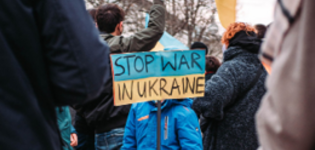Blog
Why Russian brutality may backfire
A political violence perspective
The Russian invasion of Ukraine has been fast shifting into a new phase, one many observers have noted is marked by increasing levels of Russian brutality and harm toward Ukraine’s population. Reports of Russian bombing of civilian targets are making headlines around the world, and tragically the killing of Ukrainian civilians is only likely to grow as the Russian invasion continues.
Research on political violence can help us understand why this shift is taking place, and — crucially — why it may ultimately fail and backfire for Russia.
Wartime violence – a continuum
First, a brief explanation of some crucial concepts is required to understand why this is the case. Scholars of wartime violence often make a key distinction between 'selective', or targeted violence (targeting enemy combatants, but not civilians), verses 'indiscriminate' violence (not distinguishing between the two). Of course, in reality, this is not simply a binary but a continuum, ranging from killing top enemy commanders on the one end (e.g., the U.S. assassination of Osama bin Laden in Pakistan in 2011) to leveling entire cities on the other (e.g., the U.S. fire-bombing of Dresden or Tokyo in the Second World War). Most wartime violence falls in between these extremes.
Much of the research on the consequences of political violence indicates that a selective use of violence is strategically advantageous if it can be successfully executed. It avoids the steep costs that often come with harming large numbers of civilians, both militarily (e.g., pushing them to take up arms against the perpetrator, or otherwise aid its opponents) as well as politically (e.g., backlash at home, around the world, etc.). Indeed, many combatants know this and even try to compensate their victims in order to maintain the perception that they use force with care.
A strategy of targeted violence
Russia’s initial strategy was to win with speed and a relatively selective use of force. They wanted to take out the Ukrainian government and its army, while (noting the caveats above) limiting civilian death to avoid inciting broad national resistance or incurring severe international and domestic backlash. In other words, this intervention was not meant to be a replication of Grozny or Syria, where Russian forces essentially flattened entire cities so that resistance would cease.
This strategy has failed. Selective violence is very difficult to execute, requiring precise targeting, accurate intelligence, and often territorial control, to be carried out effectively. Russia had none of these sufficiently in Ukraine.
Civilians caught in the crossfire
Russia is turning toward increasingly 'indiscriminate' forms of violence. They do not control Kyiv nor most other key Ukrainian cities, but are aiming to surround and encircle them. They want the Ukrainian government to comply with their wishes, but can only coerce it with methods that will harm civilians (e.g., shelling, airstrikes, siege tactics, etc.) in the process.
Indiscriminate violence is very risky, and only has a reasonable chance of success when it is pushed to true extremes. The nuclear bombing and destructive fire-bombing of Japanese cities did help end the Second World War, and wars in places like Chechnya did fizzle out after the complete destruction of opposing population centers showed the futility of resistance. Similarly, there is strong evidence that the counterinsurgency campaigns common in nineteenth and twentieth century European colonialism were only successful in many cases due to their brutal and indiscriminate tactics, including a willingness to commit mass atrocities and obliterate opposing communities into compliance.
The issue is that Russia will have tremendous difficulty in going to these kinds of extremes due to, among other factors, the close cultural and social ties it has with Ukrainians and the symbolic value of their cities in Russia. Trying to reduce Kyiv to ash is likely to massively boost backlash at home, crater Russian soldiers’ morale, and perhaps lead to greater risk of Putin’s rule being toppled. Increasing levels of brutality and indiscriminate force will also strengthen global backlash and economic sanctions, which will further destabilize Russia and jeopardize Putin and his inner circle’s grip on power.
Between a rock and a hard place
In this sense, Russia is stuck. They cannot win with a selective and targeted use of force and cannot escalate to extreme indiscriminate violence without entailing severe costs back home. Ultimately, they will likely turn toward increasingly indiscriminate tactics such as shelling, missiles, airstrikes, and the like on broad sections of Kyiv and other Ukrainian population centers, but without trying to totally lay waste to them. This is arguably the worst of all worlds for the Kremlin. It will harden and provoke Ukrainian resistance, and intensify backlash at home and around the world, but it will not be enough to punish the Ukrainian people to comply.
Further, these dynamics will also complicate any effort to suppress the Ukrainian insurgency or resistance movement that is likely to emerge should Russia succeed in at least temporarily taking over the country. Russia would struggle to employ selective violence effectively against such a movement, and it would continue to face severe alienation within Ukraine, backlash at home, and sanctions around the world if it adopted a more brutal and indiscriminate approach.
In summary, Putin has made a particularly costly strategic miscalculation by attempting to invade and subjugate both a strong and a culturally similar nation. Russia is not powerful enough to defeat Ukraine with a knife, and it will be deeply reluctant to obliterate it totally with a hammer (although it will assuredly move in that direction). Understanding this makes clear the deep strategic bind in which the Russian regime finds itself and its ruinous war right now.
Daniel Silverman is an Assistant Professor of Political Science in the Institute for Politics and Strategy at Carnegie Mellon University. He is the author of an upcoming WIDER Working paper on protests in post-ISIS Iraq.
The views expressed in this piece are those of the author(s), and do not necessarily reflect the views of the Institute or the United Nations University, nor the programme/project donors.
 Join the network
Join the network















